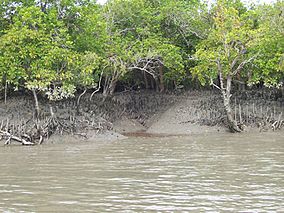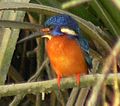Sundarbans National Park facts for kids
Quick facts for kids Sundarbans National Park |
|
|---|---|
| [সুন্দরবন জাতীয় উদ্যান Shundorbôn Jatio Uddan] Error: {{Lang-xx}}: text has italic markup (help) | |
|
IUCN Category II (National Park)
|
|

Mangrove trees in Sundarbans
|
|
| Lua error in Module:Location_map at line 420: attempt to index field 'wikibase' (a nil value). | |
| Location | South 24 Parganas, West Bengal, India |
| Area | 1330.12 |
| Established | 1984 |
| Governing body | Government of India, Government of West Bengal |
| Sundarbans National Park * | |
|---|---|
| Country | India |
| Type | Natural |
| Criteria | ix, x |
| Reference | 452 |
| Region ** | Asia-Pacific |
| Inscription history | |
| Inscription | 1987 (11th Session) |
|
|
The Sundarbans National Park is a special place in India. It is a National Park, a Tiger Reserve, and a Biosphere Reserve. This means it is protected to save its amazing nature. It is located in the Sundarbans delta in West Bengal.
This park is famous for its thick mangrove forests. These are trees that grow in salty water. It is also one of the biggest homes for the Bengal tiger. Many other animals live here too, like birds, reptiles, and tiny creatures called invertebrates. You can even find the huge salt-water crocodile here! The Sundarbans National Park became a National Park on May 4, 1984.
The delta has seven main rivers and many smaller waterways. They all flow south towards the sea. The coast has many flat, muddy areas. These mudflats are perfect for mangrove trees to grow. There are 64 different kinds of plants in this area.
Contents
Plants of Sundarbans: What Grows Here?
The Sundarbans has 64 types of mangrove plants. These plants are special because they can live in salty water. In April and May, you can see beautiful colors. The Genwa tree (Excoecaria agallocha) has bright red leaves. The Kankra (Bruguiera gymnorrhiza) has red flowers that look like crabs. The Khalsi (Aegiceras corniculatum) has yellow flowers.
Other common plants and trees in the park include Dhundal (or cannonball mangrove, Xylocarpus granatum). You can also find Passur (Xylocarpus mekongensis), Garjan (Rhizophora spp.), Sundari (Heritiera fomes), and Goran (Ceriops decandra).
Animals of Sundarbans: Who Lives Here?
The Sundarbans forest is home to over 400 Royal Bengal Tigers. These tigers are unique because they can swim in the salty water. They are known for being very strong. You can often see tigers resting in the sun on river banks between November and February.
Besides the Royal Bengal Tiger, many other animals live here. These include Fishing Cats, Leopard Cats, Macaques, and Wild Boars. You might also spot Indian Grey Mongooses, Foxes, Jungle Cats, Flying Foxes, Pangolins, and Chital deer.
Birds of Sundarbans: Feathered Friends
Many different birds live in the Sundarbans. Some common ones are openbill storks and black-headed ibis. You can also see Water Hens, Coots, and Pheasant-tailed Jacanas. Birds of prey like Pariah Kites, Brahminy Kites, and Marsh Harriers fly overhead.
Other birds include Swamp Partridges, Red Junglefowls, and Spotted Doves. Songbirds like Common Mynahs and Jungle Crows are also present. Water birds like Cotton Teals, Herring Gulls, and Caspian Terns are often seen. You might also spot Gray Herons, brahminy ducks, and Spot-billed Pelicans.
Water Animals: Life in the Rivers
The park's waters are full of life. Some fish you can find are Sawfish, Butter Fish, Electric rays, and Silver carp. There are also Star Fish, Common Carp, and King Crabs. Smaller creatures like Prawns and Shrimps are common.
One special animal is the Gangetic Dolphin. You might also see amphibians like Skipping Frogs, Common Toads, and Tree Frogs.
Reptiles: Scaly Residents
The Sundarbans National Park has many different reptiles. Large estuarine crocodiles live in the water. You can also find chameleons and monitor lizards. Several types of turtles are here, including Olive Ridley, hawksbill, and green turtles.
Many Snakes live in the park. These include large pythons and dangerous King Cobras. Other snakes are rat snakes, Russell's vipers, Dog Faced Water Snakes, Chequered Killbacks, and Common Kraits.
Endangered Species: Protecting Rare Animals
The Sundarbans is a very important place for many animals that are in danger of disappearing. These include the famous Royal Bengal Tiger and the huge Saltwater Crocodile. Other endangered animals are the River Terrapin, Olive Ridley Turtle, and the Gangetic dolphin. You can also find the Ground Turtle, Hawks Bill Turtle, and the Mangrove horseshoe crab here. Protecting these animals is a big reason why the park exists.
Ecosystem: A Special Natural System
In 2001, the Sundarbans became a Biosphere Reserve. This means its unique natural system, or ecosystem, is recognized by UNESCO. It is part of their Man and the Biosphere (MAB) Programme. This program helps protect important natural areas around the world.
Related pages
Images for kids
-
Map of the protected areas of the Indian Sunderban, showing the boundaries of the Tiger Reserve, the National Park and the three wildlife sanctuaries, conservation and lodging centres, subsistence towns, and access points. The entire forested (dark green) area constitutes the Biosphere Reserve, with the remaining forests outside the national park and wildlife sanctuaries being given the status of a Reserve Forest.
-
Cyclonic Storm Aila on May 24, 2009 - Image by NASA
See also
 In Spanish: Parque nacional de Sundarbans para niños
In Spanish: Parque nacional de Sundarbans para niños








